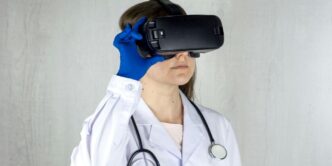Hospitals are always looking for new ways to do things better. In 2025, we’re going to see some really big changes in healthcare. These hospital innovations will help patients get better care, make hospitals run smoother, and even help more people get the care they need. It’s all about using new ideas and technology to improve things for everyone.
Key Takeaways
- Digital tools, like telemedicine, are making it easier for people to get medical help, no matter where they are.
- Hospitals are using AI to handle everyday tasks, which means staff can spend more time helping patients.
- Robots are starting to do things like deliver supplies, making hospital operations more efficient.
- New treatments based on things like a person’s genes are becoming more common, offering very specific care.
- Hospitals are using technology to make sure patients get the right follow-up care, which helps them stay healthy and happy.
Advancing Patient Care Through Digital Health
Digital health is really changing how we approach patient care. It’s not just about fancy gadgets; it’s about making healthcare more accessible, convenient, and effective for everyone. We’re seeing some cool advancements that are set to become standard practice by 2025.
Telemedicine for Enhanced Access
Telemedicine has exploded, and it’s not slowing down. It’s removing geographical barriers and making healthcare available to people who might not otherwise have access. Think about rural communities or patients with mobility issues. Telemedicine is a game-changer. I think digital health tools will continue to grow in popularity.
- Virtual consultations are becoming more common.
- Remote monitoring of patients is improving chronic disease management.
- Specialist consultations are now available to remote areas.
Digital Tools for Patient Engagement
Getting patients actively involved in their own care is key. Digital tools are making this easier than ever. Patients can track their health data, communicate with their providers, and access educational resources all from their smartphones. This leads to better adherence to treatment plans and improved outcomes. I think patient engagement is key to better outcomes.
- Mobile apps for medication reminders.
- Wearable devices for tracking vital signs.
- Online portals for accessing medical records and scheduling appointments.
Optimizing Digital Strategy
It’s easy to get caught up in the excitement of new technologies, but it’s important to have a solid digital strategy. Hospitals need to carefully consider which tools are the best fit for their patients and providers, and how to integrate them effectively into existing workflows. A disjointed approach can lead to confusion and frustration. I think digital strategy is critical to success.
- Developing clear goals and objectives for digital health initiatives.
- Investing in training and support for staff.
- Ensuring data privacy and security.
Revolutionizing Operations with Artificial Intelligence
AI is making big waves in healthcare, and by 2025, it’s going to be even more integrated into how hospitals run. We’re not just talking about fancy gadgets; AI is changing the nuts and bolts of hospital operations, making things faster, cheaper, and hopefully, better for everyone. It’s about making smarter decisions and freeing up staff to focus on what really matters: patient care.
AI for Administrative Efficiency
Let’s be real, hospital admin can be a nightmare. Mountains of paperwork, endless phone calls, and scheduling conflicts galore. AI can step in and automate a lot of this. Think about it: AI-powered virtual assistants handling appointment booking, answering basic questions, and even providing medication reminders. This frees up staff to focus on more complex tasks. AI-powered tools can streamline tasks like medical coding and patient record management, reducing costs and improving efficiency. It’s not about replacing people, but about making their jobs easier and more efficient.
Predictive Analytics for Improved Outcomes
Imagine being able to predict which patients are at risk of developing complications or needing extra care. That’s the power of predictive analytics. AI algorithms can analyze patient data to identify trends and patterns, allowing doctors to intervene early and prevent serious problems. This isn’t just about saving money; it’s about saving lives. By enhancing the speed and precision of medical decisions, AI agents empower clinicians to focus more on delivering compassionate, human-centered care. It’s like having a crystal ball that helps you make better decisions.
Autonomous Coding for Revenue Cycle
Medical coding is a complex and time-consuming process, but it’s essential for getting paid. Autonomous coding systems use AI to automatically assign the correct codes to medical procedures and diagnoses. This not only speeds up the billing process but also reduces errors and ensures that hospitals are properly reimbursed for their services. This is especially useful in small clinic coding software, where resources might be limited. It’s a win-win for hospitals and patients alike.
Enhancing Efficiency Through Automation and Robotics
It’s no secret that hospitals are facing increasing pressure to do more with less. Staff shortages, rising costs, and the ever-growing demands of patient care mean that finding ways to boost efficiency is more important than ever. That’s where automation and robotics come in. These technologies offer the potential to streamline operations, reduce errors, and free up staff to focus on what they do best: caring for patients.
Robotic Transportation and Delivery
Imagine a hospital where robots handle the mundane tasks of moving supplies, medications, and lab samples. It’s not science fiction; it’s happening now. Robotic transportation systems are becoming increasingly common, and for good reason. They can work 24/7, don’t require breaks, and are incredibly reliable. This frees up nurses and other staff to spend more time with patients, improving both the quality of care and staff satisfaction. Think about it: no more running around searching for supplies – the robot brings them right to you.
Automation for Workforce Redesign
Automation isn’t just about replacing human workers; it’s about redesigning workflows to make better use of everyone’s skills. By automating repetitive tasks, hospitals can free up staff to focus on more complex and rewarding work. This can lead to increased job satisfaction and reduced burnout. For example, automating the process of scheduling appointments can free up administrative staff to focus on patient communication and support. It’s about working smarter, not harder.
Streamlining Supply Chain Management
The supply chain is a critical but often overlooked area where automation can make a big difference. From ordering and inventory management to delivery and distribution, there are numerous opportunities to streamline processes and reduce waste. Automated systems can track inventory in real-time, predict demand, and automatically reorder supplies when needed. This not only reduces costs but also ensures that hospitals always have the supplies they need to provide the best possible care. Here’s a quick look at the potential impact:
- Reduced inventory costs by 15-20%
- Improved order accuracy by 25%
- Decreased stockouts by 30%
Personalized Medicine and Advanced Therapies
Personalized medicine is really taking off, especially now that we can get genetic info easier. By next year, treating people based on their genes will be normal. It’s about getting treatments that work better, with fewer bad reactions, and better results, especially for long-term illnesses. It’s not just about genes, though. It’s about using all sorts of data to make healthcare plans that fit each person.
Genomics-Driven Personalized Therapies
Genomics is changing how we treat diseases. Instead of a one-size-fits-all approach, we’re looking at each person’s DNA to figure out the best treatment. This means better drugs, fewer side effects, and treatments that actually work. It’s like having a custom-made plan for your health. Medical assistants, lab technicians, and clinical staff will be responsible for managing genetic data, assisting in tests, and helping doctors create personalized care plans for their patients.
3D Modeling for Treatment Planning
3D modeling is becoming a big deal in treatment planning. Doctors can use these models to see exactly what’s going on inside a patient’s body. This is super helpful for planning surgeries and other treatments. It’s like having a roadmap before you even start.
Advanced Robotics in Surgery
Robotics in surgery is getting more advanced. Robots can do surgeries with more precision and less pain for the patient. This means smaller scars, faster recovery times, and better outcomes overall. It’s not about robots replacing doctors, but about them helping doctors do their jobs even better. AI is making big promises: Smarter, more personalised care.
Optimizing Clinical Workflows with Innovative Technologies

Healthcare is a field that’s constantly evolving, and one of the biggest changes we’re seeing is the push to make clinical workflows more efficient. It’s not just about doing things faster; it’s about making sure healthcare professionals can focus on what matters most: patient care. Innovative technologies are playing a huge role in this transformation. Let’s take a look at some key areas.
Ambient Listening for Documentation
Imagine a world where doctors don’t have to spend hours typing notes after each patient visit. That’s the promise of ambient listening technology. These systems use AI to automatically transcribe conversations between doctors and patients, creating accurate and detailed medical records. It’s like having a virtual scribe that captures everything, freeing up clinicians to focus on the patient in front of them. This tech is still pretty new, but early adopters are already seeing big improvements in efficiency and satisfaction. surgical advancements are making these technologies more accessible.
Digitizing Pathology Workflows
Pathology is a critical part of diagnosing diseases, but traditional pathology workflows can be slow and labor-intensive. Digitizing these workflows involves scanning tissue samples and using software to analyze them. This has a few key benefits:
- Faster Turnaround Times: Digital pathology allows pathologists to review cases remotely and collaborate with colleagues more easily, speeding up the diagnostic process.
- Improved Accuracy: AI-powered image analysis can help pathologists identify subtle patterns and anomalies that might be missed by the human eye.
- Better Collaboration: Digital images can be easily shared and annotated, making it easier for pathologists to consult with experts around the world.
Remote Patient Monitoring for Chronic Conditions
Managing chronic conditions like heart failure and diabetes can be a real challenge, both for patients and healthcare providers. Remote patient monitoring (RPM) uses wearable devices and other technologies to track patients’ vital signs and other health data from the comfort of their own homes. This data is then transmitted to healthcare providers, who can use it to identify potential problems early and intervene before they become serious. Remote monitoring can significantly reduce the cost of chronic conditions.
RPM offers several advantages:
- Improved Patient Outcomes: By monitoring patients’ health data in real-time, providers can identify and address potential problems early, preventing hospitalizations and improving overall health outcomes.
- Reduced Healthcare Costs: RPM can help reduce the need for expensive hospital visits and emergency room care.
- Increased Patient Engagement: RPM empowers patients to take a more active role in their own care, leading to better adherence to treatment plans and improved self-management skills.
These technologies are not just about making things easier for healthcare providers; they’re about improving the quality of care for patients. By optimizing clinical workflows, we can free up clinicians to spend more time with patients, provide more personalized care, and ultimately improve health outcomes. It’s an exciting time to be in healthcare, and I can’t wait to see what other innovations the future holds. AI solutions are also helping with administrative tasks.
Addressing Healthcare Disparities Through Innovation
It’s no secret that healthcare isn’t equal for everyone. Some people have easy access to great care, while others struggle to get even basic treatment. Innovation can play a huge role in fixing this, but it needs to be done thoughtfully. We can’t just assume new tech will automatically solve the problem; we have to be intentional about making things fairer.
Equitable Access to Care
One of the biggest challenges is making sure everyone, regardless of their background or location, can get the care they need. Telemedicine is a start, but it’s not a complete solution. We need to think about things like transportation, language barriers, and cultural differences. Innovation should focus on creating solutions that are truly accessible to all. For example, mobile clinics equipped with the latest diagnostic tools can bring healthcare directly to underserved communities. Also, telemedicine and AI can help scale diagnostics.
Unbiased Data and Algorithm Monitoring
AI is becoming a bigger part of healthcare, but it’s only as good as the data it learns from. If that data reflects existing biases, the AI will perpetuate those biases, potentially making disparities even worse. It’s crucial to monitor algorithms and data sets for any signs of unfairness. This means actively seeking out and correcting biases to ensure AI tools are used ethically and equitably. We need to ask ourselves: How do we ensure AI doesn’t widen the gap between high-resource hospitals and underserved communities?
Innovation for Underserved Areas
Rural hospitals are facing huge challenges, and many are at risk of closing. This leaves people in those areas with even fewer options for healthcare. Innovation needs to focus on developing solutions specifically for these underserved areas. This could include things like:
- Remote monitoring programs: Allowing patients to receive care at home, reducing the need for travel.
- Partnerships with community organizations: Working together to address the social determinants of health, such as food insecurity and housing instability.
- Training local healthcare providers: Equipping them with the skills and resources they need to provide high-quality care.
Ultimately, the goal is to ensure that everyone, no matter where they live or what their background is, has access to the healthcare they deserve. We need to ensure equitable access to care for all individuals.
Improving Patient Follow-Up and Engagement

It’s no secret that keeping patients engaged after they leave the hospital or clinic is tough. But it’s also super important. Good follow-up care can seriously cut down on readmission rates and make sure people actually stick to their treatment plans. We’re seeing some cool tech and new approaches that are making a real difference.
Technology for Identifying Follow-Up Needs
Figuring out who needs follow-up and when is half the battle. Tech combined with smart data analysis is helping hospitals pinpoint those patients who are most at risk if they don’t get the right care after discharge. Think about it: instead of a blanket approach, resources can be focused on individuals who really need that extra support. For example, analytics identify patients from the ED who weren’t admitted but need to see a specialist quickly, or NICU babies needing outpatient care.
Concierge Practices for Scheduling
Let’s be real, navigating the healthcare system can be a nightmare. Concierge practices are stepping in to make scheduling follow-up appointments way easier. This isn’t just about convenience; it’s about removing barriers to care. Imagine having someone dedicated to helping you book appointments, coordinate tests, and answer all your questions. It’s a game-changer for patient experience and adherence to treatment plans. It’s like having a personal assistant for your healthcare needs.
Increased Patient Satisfaction and Utilization
Happy patients are more likely to stick with their care plans and use in-network services. When follow-up is easy and personalized, satisfaction goes up. And when satisfaction goes up, so does utilization of the healthcare system. It’s a win-win. Plus, increased patient satisfaction can directly impact CMS Star Ratings. Health systems that use technology to identify follow-up needs and implement concierge practices will likely see significant results, including higher in-network utilization and improved financial outcomes from additional follow-up care.
Wrapping Things Up
So, as we look ahead to 2025, it’s clear that hospitals are really stepping up their game. We’re talking about a future where getting care is easier and more personal. Things like smart tech and new ways of doing things are changing how doctors and nurses work, and how patients get better. It’s all about making healthcare better for everyone. These changes are happening fast, and it’s exciting to see how much good they’ll do.
Frequently Asked Questions
How are hospitals using new tech to make things easier for staff?
Hospitals are using cool new tools like robots to move stuff around, and smart computer programs to handle office work. This helps nurses and doctors spend more time with patients instead of doing paperwork. It’s all about making things run smoother and letting healthcare workers focus on what they do best: taking care of people.
Will new technologies help doctors give me better, more personal care?
Yes, definitely! New tech helps doctors figure out the best treatments for each person by looking at their unique body information. Think of it like a custom-made plan just for you. This means better care that fits what you need.
How can technology help predict my health needs?
Hospitals are using special computer programs that can predict if someone might get sick or need certain care. This helps them get ahead of problems and offer help before things get worse, leading to better health for everyone.
How is technology making healthcare fairer for everyone?
New technology is helping hospitals reach more people, especially those who live far away or have trouble getting to appointments. They’re also making sure that the computer programs and information they use are fair for everyone, so no one gets left out.
What’s being done to make sure I get good follow-up care after I leave the hospital?
Hospitals are using technology to make sure you get the right follow-up care after a visit. This includes using special tools to figure out who needs extra check-ins and even having people help you schedule those appointments. The goal is to make sure you stay healthy and happy with your care.
How does new technology help doctors during my visit and when I’m at home?
Hospitals are using smart listening devices to help doctors and nurses write down notes during your visit, so they don’t have to type as much. This frees them up to pay more attention to you. Also, they’re using technology to check on patients from home, especially those with long-term health issues.














